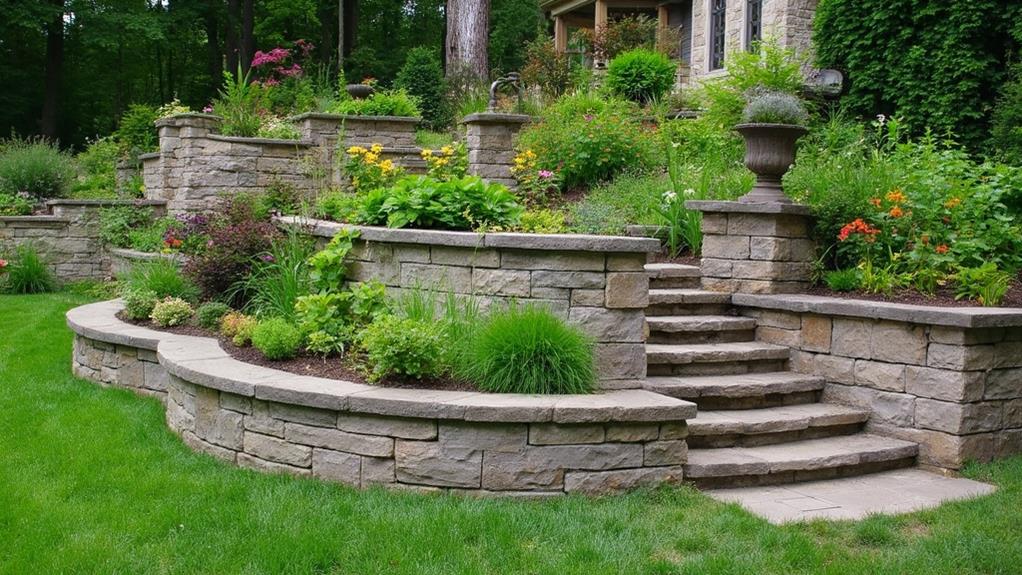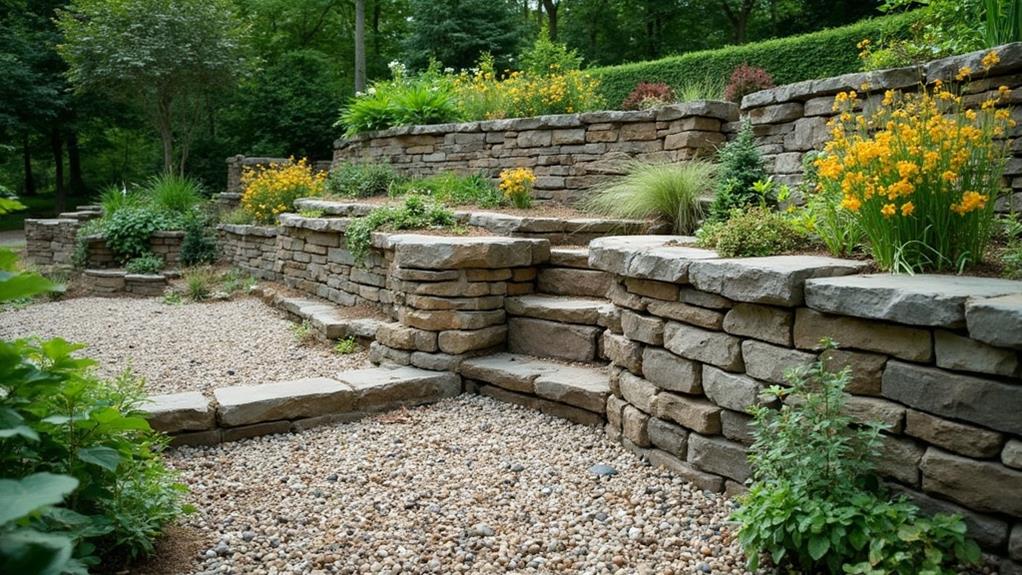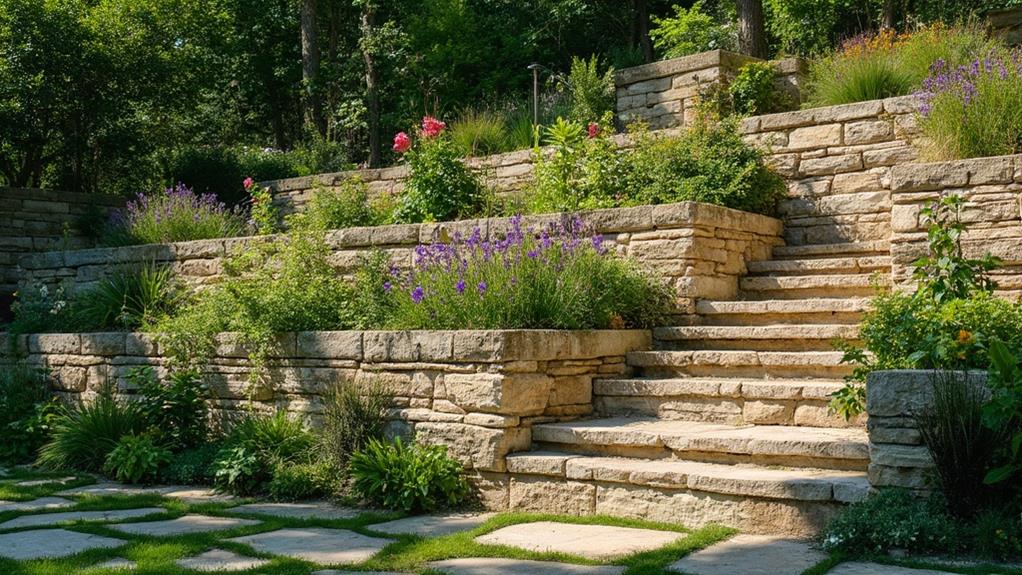Effective retaining wall design demands a thorough assessment of soil stability, encompassing geological analysis and understanding load-bearing capacity to mitigate potential slip surfaces. Incorporating an efficient drainage system is essential to reduce hydrostatic pressure and prevent soil saturation, employing permeable materials and strategic placement of drainage components. Material selection hinges on the application of site-specific criteria, balancing structural efficacy and environmental stewardship, while materials like recycled plastics may offer sustainable alternatives. Structural integrity must be assured through robust reinforcement and regular inspection, ensuring resistance to lateral earth pressures. By embracing these practices, one can access improved performance and structural longevity.
Table of Contents
ToggleWalls Contractor Highlights
- Conduct a comprehensive soil stability assessment using advanced modeling techniques for accurate evaluation.
- Integrate a drainage system to reduce hydrostatic pressure and prevent soil saturation.
- Select materials based on site-specific conditions, considering both performance and environmental impact.
- Design retaining walls to enhance outdoor space functionality and aesthetic appeal.
- Implement erosion prevention measures by considering topography and hydrology to maintain terrain integrity.
The Foundation of Retaining Walls

A robust foundation is imperative for retaining wall stability, beginning with a thorough soil stability assessment to verify that the subgrade can support the structure's weight and resist lateral earth pressures. Specialized equipment is essential for efficient project completion and safeguarding structural integrity.
Equally critical is the implementation of an effective drainage system, as proper water management prevents hydrostatic pressure that could compromise structural integrity. Additionally, careful material selection, taking into account factors such as durability, load-bearing capacity, and environmental compatibility, serves as the final cornerstone in the foundational design of retaining walls.
Soil Stability Assessment
Understanding soil stability is paramount to the design and construction of retaining walls. It is a foundational aspect that guarantees these structures perform effectively over their lifespan.
Soil stability assessment involves a detailed investigation of the existing geological and soil conditions at the construction site. This includes evaluating soil composition, density, moisture content, and load-bearing capacity. Proactively analyzing these elements assists in predicting how the soil will behave under the imposed loads from the retaining wall.
A thorough soil stability assessment also entails examining potential slip surfaces, identifying any previous soil movement, and calculating the factor of safety for the proposed design. This process involves geotechnical surveys, laboratory tests, and analyses that provide vital data to guide engineering decisions.
Soil heterogeneity and anisotropy often demand advanced modeling techniques, such as finite element analysis, to predict complex interactions between soil and structure accurately.
Drainage System Importance
Proper drainage systems are critical to the structural integrity and longevity of retaining walls. The absence of an effective drainage solution can lead to detrimental water accumulation behind the wall, exerting hydrostatic pressure that undermines its stability and hastens its degradation. Incorporating an extensive drainage approach is, as a result, essential to safeguard both the functionality and durability of these engineering structures.
A well-planned drainage system fulfills several pivotal roles:
- Reduction of Hydrostatic Pressure: By enabling proper water flow, a drainage system diminishes water pressure buildup, thereby averting potential structural failure.
- Mitigation of Soil Saturation: Facilitating water evacuation helps maintain soil stability, preventing adverse effects such as erosion and potential landslides.
- Prevention of Freeze-Thaw Cycles: Draining excess moisture circumvents the freeze-thaw cycle that can lead to material cracking and accelerated wear.
Meticulous attention to drainage design complements the natural terrain, ensuring that water channels away from the wall efficiently. Implementing permeable backfill materials, drainage pipes, and weep holes within the design will greatly improve its performance. As active participants in creating robust retaining walls, it becomes our collective responsibility to instill a sense of unity in prioritizing these drainage best practices, reinforcing the walls that uphold our environments.
Material Selection Criteria
Selecting appropriate materials is paramount in the design of retaining walls, as it directly impacts their stability, durability, and performance. The foundational criteria for material selection should consider factors such as the soil type, environmental conditions, load-bearing requirements, and aesthetic preferences.
Concrete, for instance, is a popular choice due to its inherent strength and adaptability to various designs and structural needs. However, it demands careful consideration of curing practices and protective coatings to enhance its longevity, particularly in environments prone to moisture infiltration or freeze-thaw cycles.
Wood, while providing a natural aesthetic appeal, often requires extensive treatment and maintenance to resist decay and insect infestation. It is ideally suited for smaller residential projects where its warm, organic appearance can complement the surrounding landscape.
Additionally, stone provides unmatched durability and timeless elegance, making it suitable for projects where aesthetics weigh heavily in design consideration. However, the initial cost and the complexity of installation can be significant drawbacks.
Incorporating sustainable materials such as recycled plastic or geosynthetic materials can offer a balanced blend of resilience and eco-friendliness. Understanding these nuances aids not only in achieving structural efficacy but also in fostering a sense of community and shared environmental stewardship.
Benefits

Retaining walls offer several significant advantages that make them essential in landscape and structural design. They enhance outdoor spaces by creating leveled areas suitable for various activities while effectively combating soil erosion, consequently preserving the integrity of the landscape.
These structures serve multiple functions, including diverting rainwater away from homes and creating usable areas for gardening, patios, and parking pads. Additionally, these structures not only provide necessary structural support but also increase property value by adding an element of aesthetic appeal and functionality to the surrounding environment.
Enhances Outdoor Space
A well-designed retaining wall can markedly enhance outdoor spaces by creating both functional and aesthetic benefits. Retaining walls serve as transformative elements within a landscape, redefining outdoor areas into more usable and visually pleasing spaces for community gatherings, family activities, and peaceful solitude.
The adaptability of a retaining wall allows it to complement the natural contours of the land while providing diverse opportunities for personalization. Residents often find a sense of belonging and pride within a cohesive and well-planned outdoor environment.
Consider the following benefits offered by enhancing outdoor spaces with retaining walls:
- Increased Usable Space: By leveling uneven terrain, retaining walls can create terraces and extended flat areas for patios, outdoor kitchens, or playgrounds, effectively turning otherwise unusable land into valuable living space.
- Aesthetic Appeal: Retaining walls can integrate into the landscape design, allowing for seamless changes between different sections of a garden or yard, and can be tailored with a variety of materials and styles to fit the desired aesthetic.
- Improved Landscape Architecture: They can delineate spaces within a garden, creating distinct zones for planting, seating, or pathways, which promotes a sense of order and organization that resonates with the elegance of structured design.
Prevents Soil Erosion
The strategic implementation of retaining walls not only enhances outdoor spaces but also addresses the significant concern of soil erosion. These structures play an essential role in stabilizing landscapes vulnerable to erosion by providing a sturdy barrier that holds back soil, thus maintaining the integrity of the terrain. Their design is paramount, involving careful consideration of the topography and hydrology of the area.
With a focus on durability and effectiveness, retaining walls efficiently manage the flow of water, preventing the displacement of soil by rain or irrigation.
Retaining walls are integral in creating a harmonious coexistence between developed and natural environments. The process of installing these walls entails a thorough understanding of soil mechanics and environmental interactions. Engineers and landscape architects collaborate to tailor solutions that fit the unique characteristics of each site, ensuring that the structure not only functions ideally but also blends aesthetically with its surroundings.
This meticulous planning and execution contribute to the wall's ability to mitigate erosion effectively, fostering a sense of security and belonging as homeowners can confidently preserve their valued landscapes. Ultimately, well-designed retaining walls epitomize the intersection of beauty and practicality, offering a sustainable approach to erosion control.
Increases Property Value
Enhancing property aesthetics and functionality can markedly increase its market value, and retaining walls are instrumental in achieving this transformation. These walls serve as a powerful tool in elevating both the visual appeal and practical aspects of a landscape. Integrating well-designed retaining walls into a property not only changes the land's shape but also inspires confidence in potential buyers by suggesting careful stewardship and thoughtful design strategies.
- Visual Appeal: Aesthetic enhancement through visually striking retaining walls can set a property apart, giving it an edge in competitive markets. Well-crafted walls offer an attractive contrast that accentuates floral arrangements and greenery.
- Usable Space: Transforming steep, unusable slopes into flat, functional areas expands outdoor living space. This optimization offers opportunities for patios, gardens, or recreation areas, which are treasured features in modern landscapes.
- Low Maintenance: A well-constructed retaining wall reduces landscape maintenance needs by eliminating problematic slopes and erosion issues, consequently offering long-term cost savings and environmental benefits.
Retaining walls embrace both artistry and utility, reflecting a property owner's values in sustainability and sophistication, while ensuring everyone feels connected to the surrounding space's enriched narrative.
Provides Structural Support
Crucial to landscape integrity, retaining walls provide essential structural support by stabilizing soil and managing slopes on challenging terrains. In challenging environments where land naturally shifts due to gravity, weather influences, or water saturation, retaining walls act as steadfast barriers that prevent erosion and landslides. These structures play a critical role in ensuring the stability and safety of both natural landscapes and human-made environments, safeguarding assets and resources within communities.
The design of retaining walls necessitates precise engineering to address both external conditions and internal stress factors, thereby reinforcing the landscape against unforeseen disruptions. By expertly redistributing lateral pressure exerted by sloping soil, retaining walls allow for the effective management of elevation changes, which is particularly beneficial in residential, commercial, and infrastructural applications. They serve to facilitate the optimization of land use, opening opportunities for cohesive community planning.
Beyond mere functional attributes, retaining walls contribute to a sense of order and security within communities, binding landscapes together with purposeful design. By implementing best practices in their creation, stakeholders can foster environments that are not only resilient and robust but also harmonious and sustainable. This sense of community cohesion creates environments in which people feel rooted and connected.
Consider Soil Drainage Requirements

Ensuring proper soil drainage is a critical component in the design of retaining walls, as it directly impacts the structure's longevity and safety. Inadequate drainage can lead to increased hydrostatic pressure, resulting in potential wall failure and erosion issues threatening the surrounding environment. The selection of appropriate drainage materials, such as gravel or geotextiles, plays a pivotal role in mitigating these risks, as illustrated in the following table:
| Drainage Aspect | Benefit | Example Materials |
|---|---|---|
| Proper Drainage | Longevity of structure | Gravel, Sand |
| Mitigating Erosion | Reduces wall failure | Drainage pipes |
| Selecting Materials | Efficient water flow | Geotextiles, Crushed Rock |
Importance of Proper Drainage
Proper drainage is one of the pivotal aspects of retaining wall design, as it directly impacts the wall's stability and longevity. Effective drainage prevents the accumulation of hydrostatic pressure, which can exert significant lateral force on the wall, leading to structural failure over time. Understanding the interplay between water, soil, and wall construction is central to engineering a solution that harmonizes with the landscape.
This engagement with the environment nurtures a sense of collaboration between engineers, architects, and the community.
To achieve ideal drainage, consider the following practices implemented in professional retaining wall design:
- Incorporate Drainage Pipes: These facilitate the swift removal of water from behind the wall, lessening pressure buildup. Typically, perforated pipes are laid at the wall's base, directing water away from the structure.
- Use of Filter Fabric: Placing filter fabric between the soil and drainage gravel prevents soil migration and clogging, ensuring continuous drainage functionality and soil retention.
- Backfill Composition: It is essential to select and compact appropriate backfill materials like gravel instead of clay, which allows for better water percolation given its lower retention properties.
Emphasizing these drainage techniques not only extends the life of retaining walls but also reinforces their role within the broader ecosystem of structures, showing respect for both human and natural communities.
Mitigating Erosion Risks
Mitigating erosion risks is a critical aspect of retaining wall design, particularly when considering soil drainage requirements. Proper understanding of the interplay between soil composition and water flow is paramount. Erosion can undermine the stability of a retaining wall, leading to costly failures. Consequently, addressing soil drainage demands an extensive analysis of the site's geotechnical properties. Ensuring the soil retains adequate strength while allowing water to evacuate safely is essential for longevity.
Central to this is the assessment of the natural and imposed drainage patterns of the locale. By understanding how water flows around and through the soil mass, designers can implement systems that minimize erosion by redirecting water away from pressure points that might erode over time. Such measures include ensuring a slight grading of surface water runoff away from the wall or integrating subsurface drainage to manage groundwater effectively.
Selecting Drainage Materials
Selecting the right drainage materials is essential in retaining wall design to handle soil drainage requirements effectively. Well-designed drainage systems mitigate the risk of hydraulic pressure build-up, promoting the longevity and stability of the structure. An effective drainage solution not only enhances the structural integrity but also fosters a sense of security among clients and communities relying on these constructions.
To achieve an ideal outcome, consider these indispensable components:
- Gravel and Crushed Stone: These materials are often selected for their permeability, enabling efficient water movement away from the wall. The choice of material should accommodate the specific hydraulic characteristics of the site.
- Drainage Pipes: A vital element that prevents water accumulation behind the wall, drainage pipes, often made of PVC or perforated plastic, should be strategically placed to facilitate unobstructed water expulsion. Proper sizing based on anticipated flow rates is paramount.
- Geotextile Fabrics: These fabrics play a pivotal role in separating soil from the drainage aggregate, enhancing durability by preventing clogging. Selecting fabrics with the correct filtration and tensile strength properties aligns with the needs of varying soil conditions.
Walls Contractor FAQ
What Materials Are Commonly Used for Designing Retaining Walls?
Retaining walls are commonly constructed using materials such as concrete, stone, brick, and timber. These materials are selected for their strength, durability, and aesthetic appeal, ensuring both functional integrity and visual harmony within the landscape.
How Long Does a Retaining Wall Generally Last?
The lifespan of a retaining wall typically ranges from 20 to 100 years, depending on materials, environmental conditions, and maintenance. Community engagement in ongoing upkeep guarantees the structure not only endures but continues to enhance shared spaces.
Can a Retaining Wall Be Built on a Slope?
A retaining wall can indeed be constructed on a slope. Proper engineering analysis, considering factors such as soil type, drainage, and structural integrity, is essential to guarantee stability and longevity, fostering a sense of security within the community.
Are There Environmental Concerns When Constructing Retaining Walls?
Environmental concerns in retaining wall construction include ecosystem disruption, soil erosion, and water runoff management. Sustainable practices, such as erosion control measures and the use of eco-friendly materials, can foster harmony with natural surroundings while ensuring structural integrity.
What Are the Costs Associated With Maintaining a Retaining Wall?
Retaining wall maintenance costs can include regular inspections, drainage management, addressing erosion, repairing structural damages, and landscape integration. Balancing these practices guarantees reliability and safety, fostering a shared commitment to environmental responsibility and community well-being.







